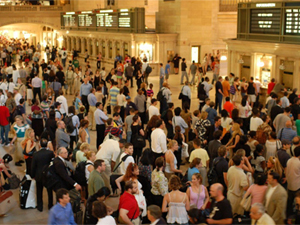



Date:21/09/18
 Researchers in the US have demonstrated how WiFi could be used to penetrate walls and count the number of people inside a room.
Researchers in the US have demonstrated how WiFi could be used to penetrate walls and count the number of people inside a room.
Devised by a group at the University of California Santa Barbara, the technique could have applications in smart energy management, retail business planning and security. "Our proposed approach makes it possible to estimate the number of people inside a room from outside," said Prof Yasamin Mostofi, who led the research.
Presented at the 2018 IEEE International Conference on Sensing, Communication, and Networking (SECON) the technology uses WiFi RSSI (received signal strength) measurements to estimate the number of people.
In the team’s experiments, one WiFi transmitter and one WiFi receiver were placed behind walls, outside a room in which up to 20 people were walking around. The transmitter sent a wireless signal whose received signal strength was measured by the receiver. The estimate of the number of people present is based on these received signal power measurements.
Mostafi’s group has previously demonstrated the use of WiFi for crowd counting, but this is the first time through-wall counting has been demonstrated. "Enabling through-wall crowd counting is considerably more challenging due to the high level of attenuation by the walls," said Mostofi.
The key to this technology is that human presence and movement can result in significant drops in the received signal strength. "Consider the event sequence that corresponds to the occurrence of significant signal drops," explained Mostafi. "An inter-event time is then the time in between two consecutive events." The researchers’ approach for enabling through-wall crowd counting is based on mathematically characterising the information content of the received signal inter-event times, and relating it to the total number of occupants.
The group used mathematical tools from renewal process literature, a theoretical field that has found applications in areas such as reliability and risk analysis to model the statistics of the inter-event times and relate them to the total number of occupants in the area.
The approach has been trialled in a number of different locations with different numbers of people, and has so far shown a counting accuracy of two people or less 100 per cent of the time.
Crowd-counting WiFi technique looks through walls
 Researchers in the US have demonstrated how WiFi could be used to penetrate walls and count the number of people inside a room.
Researchers in the US have demonstrated how WiFi could be used to penetrate walls and count the number of people inside a room.Devised by a group at the University of California Santa Barbara, the technique could have applications in smart energy management, retail business planning and security. "Our proposed approach makes it possible to estimate the number of people inside a room from outside," said Prof Yasamin Mostofi, who led the research.
Presented at the 2018 IEEE International Conference on Sensing, Communication, and Networking (SECON) the technology uses WiFi RSSI (received signal strength) measurements to estimate the number of people.
In the team’s experiments, one WiFi transmitter and one WiFi receiver were placed behind walls, outside a room in which up to 20 people were walking around. The transmitter sent a wireless signal whose received signal strength was measured by the receiver. The estimate of the number of people present is based on these received signal power measurements.
Mostafi’s group has previously demonstrated the use of WiFi for crowd counting, but this is the first time through-wall counting has been demonstrated. "Enabling through-wall crowd counting is considerably more challenging due to the high level of attenuation by the walls," said Mostofi.
The key to this technology is that human presence and movement can result in significant drops in the received signal strength. "Consider the event sequence that corresponds to the occurrence of significant signal drops," explained Mostafi. "An inter-event time is then the time in between two consecutive events." The researchers’ approach for enabling through-wall crowd counting is based on mathematically characterising the information content of the received signal inter-event times, and relating it to the total number of occupants.
The group used mathematical tools from renewal process literature, a theoretical field that has found applications in areas such as reliability and risk analysis to model the statistics of the inter-event times and relate them to the total number of occupants in the area.
The approach has been trialled in a number of different locations with different numbers of people, and has so far shown a counting accuracy of two people or less 100 per cent of the time.
Views: 563
©ictnews.az. All rights reserved.Similar news
- Justin Timberlake takes stake in Facebook rival MySpace
- Wills and Kate to promote UK tech sector at Hollywood debate
- 35% of American Adults Own a Smartphone
- How does Azerbaijan use plastic cards?
- Imperial College London given £5.9m grant to research smart cities
- Search and Email Still the Most Popular Online Activities
- Nokia to ship Windows Phone in time for holiday sales
- Internet 'may be changing brains'
- Would-be iPhone buyers still face weeks-long waits
- Under pressure, China company scraps Steve Jobs doll
- Jobs was told anti-poaching idea "likely illegal"
- Angelic "Steve Jobs" loves Android in Taiwan TV ad
- Kinect for Windows gesture sensor launched by Microsoft
- Kindle-wielding Amazon dips toes into physical world
- Video game sales fall ahead of PlayStation Vita launch





















